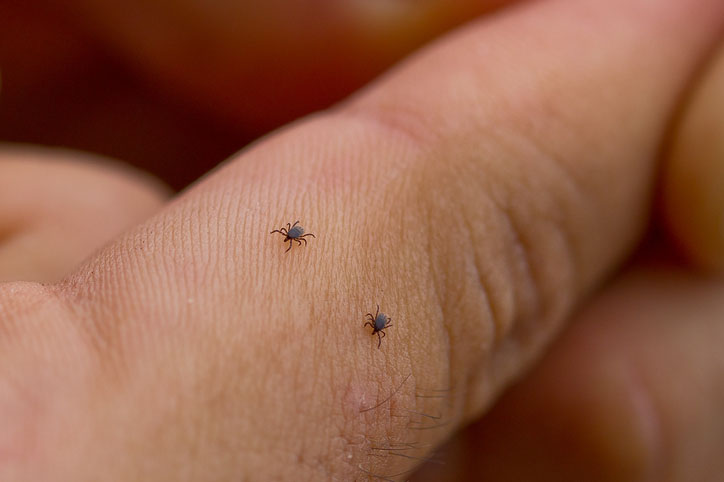Prolonged Gestation Associated with Fetal Deformity
- Prolonged Gestation in Cattle and Sheep
- Overview of Prolonged Gestation in Cattle and Sheep
- Prolonged Gestation Associated with Fetal Death
- Prolonged Gestation Associated with Fetal Deformity
Prolonged gestation associated with fetal deformity cases usually occur as the result of some compromise of the hypothalamic-pituitary-adrenal axis of the fetus, which is no longer able to initiate parturition. The affected fetus may either die and be aborted or live on indefinitely in the uterus. Genetic, infectious, toxic, and unknown causes have been associated with this problem.
Genetic Abnormalities:
Prolonged gestation associated with fetal adrenal malfunction is a genetically determined prolonged gestation caused by an autosomal recessive gene of the fetus in Holstein-Friesian cows. The fetal adrenal glands fail to produce corticosteroids at term, in response to fetal ACTH. As a result, the fetus continues to grow until it outgrows its blood supply. Induction with dexamethasone does not induce normal labor and parturition because of insufficient preparation of the birth canal. A cesarean section will save the dam, but the fetus invariably dies due to adrenal insufficiency.
Four further genetic abnormalities associated with prolonged gestation in various breeds of cattle involve fetal pituitary abnormalities. In one condition, severe fetal oversize (fetal giantism) is present. In the second, the calf has severe craniofacial defects and is much smaller than normal. In the third condition, multiple skeletal abnormalities are present. In a fourth condition, genetic abnormalities may occur as a result of cloning.
Prolonged gestation and fetal giantism has been reported in Holstein-Friesian, Ayrshire, and Swedish breeds of cattle. Gestation is prolonged by 21–150 days. Pronounced abdominal enlargement is seen in some cases. There is no attempted parturition unless the fetus dies first after having outgrown its blood supply. Cervical relaxation is poor, and dystocia invariably results. The calf weighs 48–80 kg at birth and shows signs of postmaturity. The coat and hooves are longer than normal, and prominent loose teeth are present in the gums. Breathing is difficult as a result of failure of surfactant release, and the calf may die from hypoglycemia. At necropsy, hypoplasia of the anterior pituitary and adrenal glands is seen.
Prolonged gestation with craniofacial defects in the fetus has been reported in Holstein-Friesian, Ayrshire, Guernsey, and Jersey breeds of cattle and is thought to be caused by a recessive gene. Affected fetuses cease to grow at 7 mo gestation. There is no spontaneous parturition in affected cattle because of the nonfunctional or absent pituitary gland in the fetus. Calves are usually dead when delivered. Some may show evidence of severe abnormalities of the cranium and face.
Prolonged gestation associated with multiple skeletal abnormalities has been reported in Hereford cattle. Affected calves show evidence of pituitary aplasia or hypoplasia. Arthrogryposis, torticollis, kyphosis, and scoliosis are present, and some calves have cleft palates.
Prolonged gestation associated with cloning has been reported in both fetal calves and lambs produced by somatic cell nuclear cloning. Early placental abnormalities have been detected in a high proportion of such animals, and placentomegaly may be seen in later pregnancy. The abnormality may result in fetal death or, if the fetus survives, in the large offspring syndrome. Spontaneous birth may not occur, and prolonged gestation results. Fetal lung and maternal mammary development is retarded and can compromise fetal survival.
Infectious Causes:
Although bovine viral diarrhea virus (see Bovine Viral Diarrhea and Mucosal Disease Complex) can cause abortion in cattle, it can also produce congenital defects in the fetus. These include cerebellar hypoplasia, anencephaly, and hydrocephaly. Affected calves may be born with severe defects of the CNS, but prolonged gestation occasionally occurs if pituitary function is compromised. The related pestivirus border disease virus (see Border Disease) can produce severe brain and coat abnormalities in fetal lambs. Pituitary compromise in such lambs can lead to prolonged gestation.
Akabane virus (see Akabane Virus Infection), found in Africa, Australia, the Middle East, and the Far East, can be transmitted by insects to both pregnant cattle and sheep. Bovine fetuses exposed to the virus at 76–104 days gestation may develop hydranencephaly (fluid-filled cavitation of the brain). Exposure to the virus at 105–174 days of pregnancy may cause both hydranencephaly and arthrogryposis. Affected fetuses may have severe brain damage. The cerebral cortex may be absent and the cranial cavity filled with fluid. Cerebellar hypoplasia may be present, and the brain stem is smaller than normal. Compromise of pituitary function in the affected fetus can lead to prolonged gestation.
Bluetongue virus (see Bluetongue), found in Africa, Australia, North and South America, and Europe, is also transmitted by insects; infection can occasionally cause prolonged gestation. The fetuses of cows exposed to the virus at 60–120 days of pregnancy developed hydranencephaly, whereas fetuses exposed later in pregnancy developed less severe CNS defects.
Gestation lengths >200 days have been recorded in ewes vaccinated during pregnancy with Rift Valley fever attenuated viral vaccine. Affected lambs developed severe brain defects and skeletal abnormalities. Some ewes developed hydrops amnion by the fourth month of gestation. Ewes in which pregnancy was not terminated developed ketosis.
Toxic Causes:
Several plant toxins cause fetal deformity and prolonged gestation when eaten accidentally or fed experimentally. When fed to sheep in early pregnancy, Veratrum californicum (skunk cabbage) produces fetal deformities, giantism, and prolonged gestation. Cranial defects and brain and eye abnormalities were seen in fetuses of ewes fed this plant at 14 days of gestation; pregnancy length in some cases was >230 days. The plant contains the amine cyclopamine, which is believed to be responsible for the fetal abnormalities. This plant also contains a number of toxic alkaloids that cause GI disturbance, dyspnea, and convulsions in sheep. Veratrum album has similarly caused prolonged gestation and fetal abnormalities in Holstein-Friesian cows in Japan.
An unidentified toxin in the plant Salsola tuberculatiformis (cauliflower saltwort) is thought to cause prolonged gestation in sheep. Pregnancy was extended >220 days, and affected lambs showed atrophy of the pituitary, adrenal, and thyroid glands. Fetuses appear to be most susceptible to the toxin in the first and third trimesters of pregnancy. Amniotic fluid continues to increase in volume in cases of prolonged gestation associated with this plant. Physical abnormalities such as cleft palate prevent normal swallowing of amniotic fluid in affected fetuses. Excessive fetal weight and the weight of accumulated fetal fluids may lead to rupture of the prepubic tendon in ewes.
- Prolonged Gestation in Cattle and Sheep
- Overview of Prolonged Gestation in Cattle and Sheep
- Prolonged Gestation Associated with Fetal Death
- Prolonged Gestation Associated with Fetal Deformity





